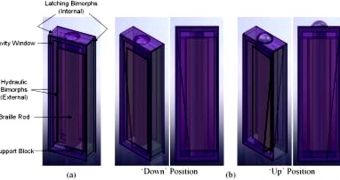A group of experts from the North Carolina State University (NC State) has taken it upon itself to promote the research and development of a new type of computer screen. The innovation, which is nearly completed, is meant to help blind people make the most out of their online experience, and also to make it easier for them to use their home computers. At this time, means of using the Internet are severely limited for these individuals, the researchers say.
Regarding their online activities, blind people are currently only limited to using, or “seeing”, a single line of text, which they feel with their fingers. Even basic activities, such as reading an e-mail, become extremely cumbersome and difficult to perform, and looking at a website, or doing research online, prove too complex to perform. What the NC State group plans to do is create a full-display Braille system, that could lead its users “see” all content on a website with a lot more ease.
“Right now, electronic Braille displays typically only show one line of text at a time. And they're very expensive,” explains study coauthor Dr Neil Di Spigna, a research assistant professor at the university. As such, he and his team are working on producing what they call a “refreshable” Braille display, that would be more functional, and also less expensive than existing systems. This communications language uses predefined sequences of elevated and recessed dots to symbolize letters, numbers, and an array of other characters as well. By moving their fingers above them, blind people can make sense of whatever information is contained in, for example, a book.
“We hope to have a fully functioning prototype of the mechanism within a year, and that could serve as the functional building block of a full-screen refreshable display,” says Di Spigna. “Reading Braille is essential to allowing blind people to find employment. We're optimistic that this technology will give the blind additional opportunities in this area,” adds NC State postdoctoral research associate and paper coauthor Dr Peichun Yang, who is also blind.
“The last 20 years of computer technology have been relatively inaccessible – and today's common mobile computing devices, from smart-phones to digital navigators and iPads, have been completely nonexistent – to blind people, because the display technology for the blind has not kept pace. We hope to enable the development of applications that will give the blind more complete access to the Internet and other computer resources, such as e-books,” concludes David Winick, another coauthor of the investigation and a researcher at the university.

 14 DAY TRIAL //
14 DAY TRIAL //